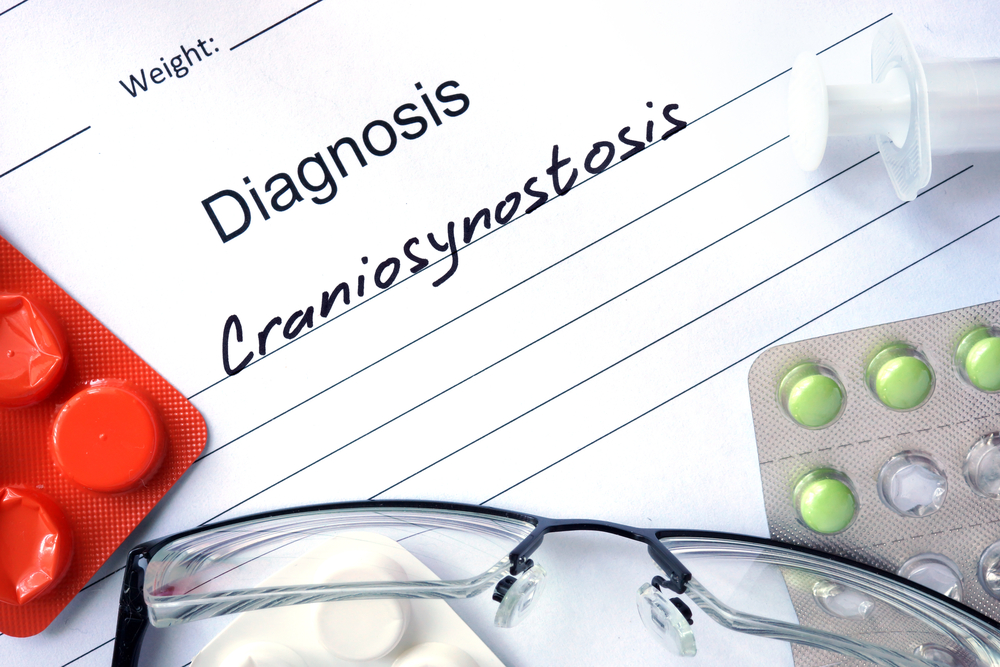Craniosynostosis

When a newborn is born with cranial synostosis, one or more of the cranial sutures, which are fibrous connections connecting the bones of the skull, seal early (fuse) before the infant's brain is fully developed. The head continues to increase in size, looking crooked.
Typically, the sutures are flexible during infancy, enabling a baby's skull to grow as the brain develops. The huge soft region (fontanel) on the top of the head where the sutures meet is located at the front of the skull. The soft area found just behind a baby's forehead is called the anterior fontanel. The back has the correspondingly largest fontanel (posterior). The skull features a little fontanel on either side.
Although numerous sutures in a baby's skull might be affected (multiple suture craniosynostosis), cranial synostosis often entails the early fusion of a single cranial suture. Rarely, some hereditary abnormalities can lead to craniosynostosis (syndromic craniosynostosis).
Types:
Following are the types of craniosynostosis:
- Brachycephaly: The coronal suture, which spans the top of the infant's skull from ear to ear, is fused on either the right or left side in anterior brachycephaly. The natural growth of the forehead and brow is stopped by this condition, which is known as coronal synostosis. As a result, the forehead and brow on the affected side become flattered, whereas the forehead tends to become too prominent on the unaffected side. Additionally, the affected side eye may look unusual in form, and the rear of the head may flatten (occipital). Posterior plagiocephaly develops due to premature fusion of lambdoid suture leads to asymmetry in the posterior cranial vault.
- Scaphocephaly: The sagittal suture is prematurely closed or fused in scaphocephaly. The top of the skull is divided by this suture, which runs from front to back. The result is a cranium that is long and thin. The skull has a long front-to-rear and a small ear-to-ear dimension.
- Trigonocephaly: Metopic (forehead) sutures fuse, resulting in trigonocephaly. The head's top to the centre of the forehead, as it descends toward the nose, is connected by this suture. An obvious ridge that runs down the forehead may develop if this suture is prematurely closed.The forehead can occasionally appear fairly pointed and look like a triangle and eyes can come close together(hypotelorism).
Symptoms:
Misshapen, disproportionate head is often the most obvious symptom of craniosynostosis. Open or closed soft spots are also possible to see. It is frequent for brain growth to be restricted due to compression , with measurements "dropping off" the pediatrician's growth curves. Pressure might build up inside the skull as a result of this. High-pressure symptoms might include:
- Headache
- Nausea
- Vomiting
- Lethargy (extremely drowsy, difficult to wake)
- Trouble lifting eyes up
- Always looking down
- No open fontanelle (soft area) can be found on a baby's head
- On the baby's head, there is a little, firm bone ridge that may be felt
- Asymmetrical or uneven-looking facial features
Alarming factors:
Craniosynostosis can be
There is no known cause of craniosynostosis. Although it's thought to be a combination of genes and environmental factors. here is typically no family background to the illness, genes may be involved. It could result from external pressure placed on a baby's head prior to delivery. The mobility and positioning of the bones as they mature may be impacted by abnormal growth of the skull's base and the membranes surrounding the skull bones.
When this runs in families, it may also be accompanied by other health issues, including seizures, a diminished IQ, and blindness. The Crouzon, Apert, Carpenter, Saethre-Chotzen, and Pfeiffer syndromes are among the genetic conditions that are frequently associated with craniosynostosis. The majority of kids with craniosynostosis, however, are generally healthy and intelligent.
Diagnosis:
A pediatrician would often examine, measure, and feel the baby's head to detect craniosynostosis. They will also search for ridges in the sutures that surround the skull.
The diagnosis can be more thoroughly confirmed by further testing. The sutures that have fused can be identified using imaging tests like X-rays and CT scans. This is very crucial to identify the condition earliest as surgery can be required to allow the normal brain development.
In case of suspicion of genetic or syndromic association the doctor could obtain a sample of the infant's blood for genetic analysis. In syndromic or proven genetic etiology in a case of craniosynostosis prenatal testing can be offered to the couple in future pregnancies.
Treatment:
Depending on the extent of the baby's symptoms, there are many treatments for craniosynostosis. Treatment options include:
- Helmet therapy: Babies with moderate craniosynostosis may use a specific medical helmet as part of their helmet therapy. Over time, this helmet gradually reshapes the skull.
- Surgery: To remodel the skull, reduce elevated intracranial pressure, and provide the baby's brain room to develop and grow normally, many newborns require head surgery. Depending on the seriousness of the ailment and the accompanying symptoms, the surgeon decides when to do the operation. During the first year of life, infants can undergo surgery.
To promote a return to regular functioning and activities, your child may require further supporting therapies, including physical, occupational, and speech therapy.
The majority of infants who receive prompt craniosynostosis therapy go on to have healthy lives. Early intervention can reduce developmental issues brought on by head strain.
Conclusion:
Most kids don't have any long-term health issues. If they have surgery, they can have a scar over the top of their head, but their hair will cover it. There will be routine check-ups to determine how your child is doing. Initially, this could happen every few weeks, but as they age, the frequency will decrease. The shape of your child's skull may require continuous care if they have certain kinds of craniosynostosis, because surgery may not always be able to completely repair it.






